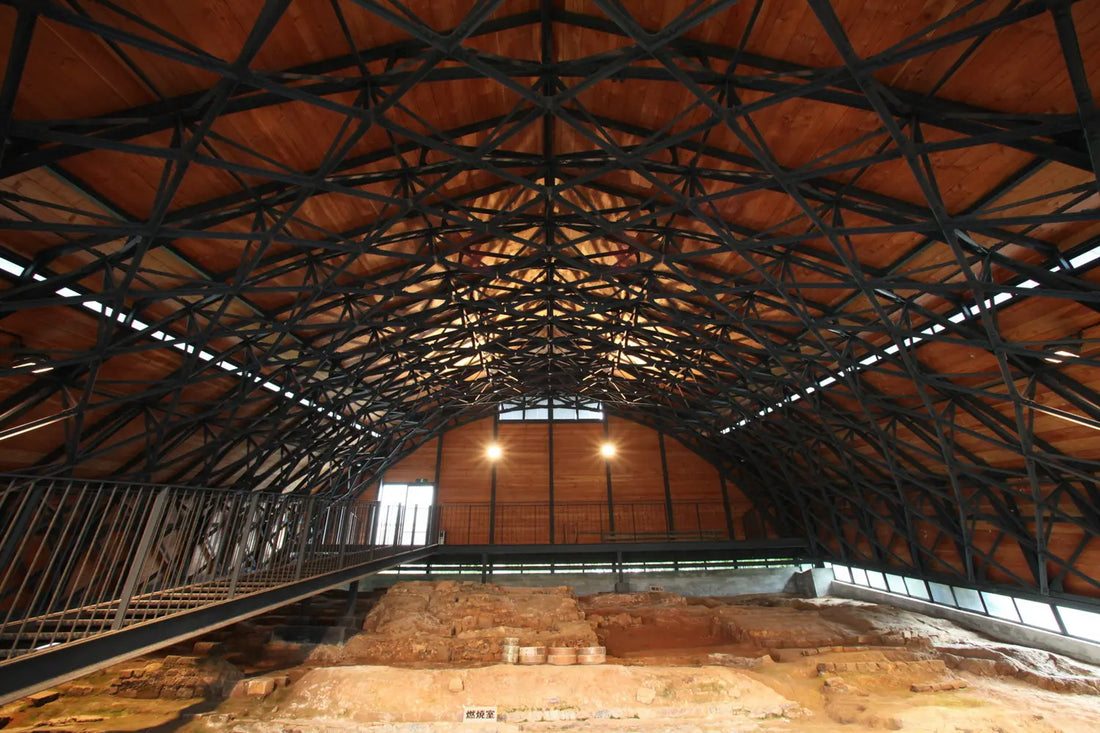Features of Kutani ware (九谷焼)
Japanese ceramics
The charm of Kutaniyaki lies mainly in its colorful decoration. The basis of Kutaniyaki's appeal lies in its five colors (red, yellow, green, purple, and navy blue), of which green, yellow, and purple play the leading roles. The depth of color created by this modest interplay of hues brings a profound richness that evokes a sense of weight and depth.
 .
. 

Next, the bold charm of Kutaniyaki lies in the brushwork. The strong outlines and overglaze painting, executed with bold brush strokes, are hand-painted in delicate harmony while maintaining an exquisite balance.
It is this interplay of color sense and brushworkthat brings the brilliantly decorated porcelain to life and creates the world of Kutani Yaki, characterized by its opulent and sumptuous decoration.
History of Kutani Ware

■ Birth of Kutani ware
Kutani ware was first produced in 1655 by Saijiro Goto in Kutani Village, Toe Ward, Kaga Province, by order of Toshiharu Maeda, the lord of Daishoji Temple. The production of Kutani porcelains began by adopting the techniques of Arita (Saga domain), famous for Imariyaki (Imari porcelain). This was the beginning of Kutani ware in the early Edo period. As for the origin of the name of this Kutani area, Kutani was the ninth village. There is a theory that it was named after it. There is another description in "Kashu Meisho Shiji" (Kashu Meisho Magazine) that says, "There are nine hundred and ninety-nine valleys in a wide mountain range and five ri in a deep valley, and they are called Kutani for short.


Later, for the next 50 years, the pieces fired in Goto Saijiro's kiln were called "Ko-Kutani" and came to be regarded as the origin of Kutani-yaki. Along with beautiful decorative styles such as "Aote" and "Iroe," it later became known as "Ko-Kutani. Its use of red, green, purple, dark blue, and yellow colors attracted special attention from cultural figures and porcelain artisans, and was passed down from generation to generation as a masterpiece.
■The revival of Kutani ware
Kutani yaki was then temporarily closed. The secret of this is still unknown. About 100 years later, in the late Edo period, the Kaga clan built the Kasugayama kiln in Kanazawa in an attempt to recreate Koya Kutani, ushering in the era of the revival of Kutani. Yoshidaya Den'emon was a man who sought to revive kutani-yaki by combining the original designs of Ko-Kutani with newly introduced techniques. His kiln, named after his shop name "Yoshidaya," was called the Yoshidaya Kilns, and he produced Kutani-yaki that was as close as possible to the old Kutani in terms of artistry and quality, while incorporating new designs and techniques to meet the changing times, and was highly regarded by the wealthy and cultured. However, due to management problems, the business was closed in 1831.

After the Yoshidaya kiln in Yamashiro closed down, Miyamoto Yaemon took over the kiln and reestablished it as the Miyamoto-ya kiln. The Miyamoto-ya kiln was influenced by the porcelain of the Kaga domain and adopted the red-painted style. Because the painter Iidaya Hachiroemon excelled in the intricate red painting, the akae porcelain of the Miyamoto-ya kiln was highly regarded. Aote Kutani declined, but regained its prominence with the Matsuyama kiln of the Daishoji clan.

■Meiji period
In the Meiji period (1868-1912), the craftsmen of the former Daishoji family worked to further improve the quality of their work and to gain prestige as a single family of craftsmen. Thanks in part to the activities of Saida Dokai and Kutani Shoza, large quantities of kutaniyaki were exported abroad. Today's Kutaniyaki is being produced more actively than ever before, with the overglaze enamel style of each period's kilns as its source. Akae" porcelain, richly decorated with gold, is the main product. Kutani Shoza's style is known for its red miniature painting and gold decoration, and he was a central figure in this movement.Later, the fame of Kutani Yaki's color-painted Kinrande (gold brocade) porcelain increased with the Vienna World Exhibition of 1873. This triggered the export of Kutani Yaki in large quantities through trade, which eventually made its name known throughout the world as "Japan Kutani".




■From the Taisho Era to the Present
During the Taisho period, products were also made in plaster molds. This was the beginning of mass production of Kutani ware. Later, due to the war, many kilns were damaged, but after the war, production flourished under the revival of traditional Japanese crafts, contributing to the local economy and re-entering the international market.
Even today, kutaniyaki is used as a gift for the Imperial Household Agency and is favored by celebrities overseas. In Japan, various kutaniyaki artists, including Living National Treasure Yoshida Minoru, continue to refine their techniques. While utilizing traditional techniques and aesthetics, attempts are being made to meet new demands, and while incorporating traditional Kutaniyaki techniques and designs, such as cups and saucers, they are also designed to meet the demand for Western-style tableware.
■Kutani Marks
Marks on the back of Kutani ware are an important source of information about the maker, kiln, and date of production of the ware.
By carefully observing the type, position, and style of the mark and comparing it to other sources, you can gain a deeper understanding of the pottery's value and history. If you would like more information on Kutani marks, please refer to this related article; https://linkinjapan.com/blogs/news/kutani-ware-markings
Kutani-yaki ranges from daily necessities to works of art, and while maintaining the tradition of displaying beautiful and graceful colors, further evolution is underway.
【Other articles about Kutani ware】


